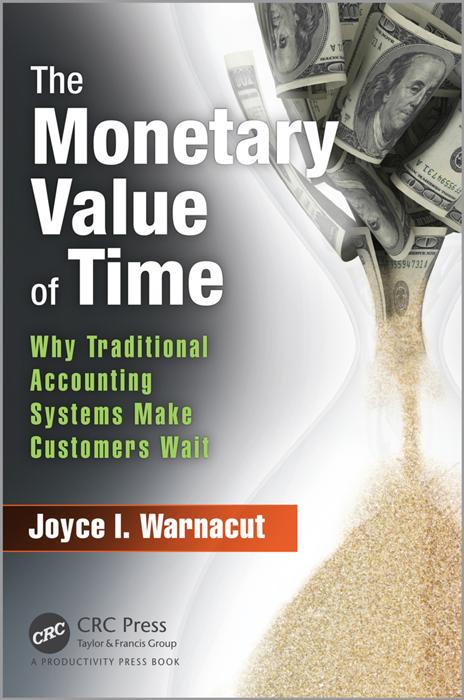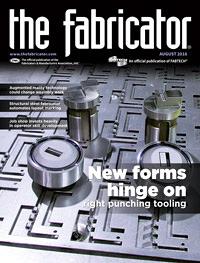Senior Editor
- FMA
- The Fabricator
- FABTECH
- Canadian Metalworking
Categories
- Additive Manufacturing
- Aluminum Welding
- Arc Welding
- Assembly and Joining
- Automation and Robotics
- Bending and Forming
- Consumables
- Cutting and Weld Prep
- Electric Vehicles
- En Español
- Finishing
- Hydroforming
- Laser Cutting
- Laser Welding
- Machining
- Manufacturing Software
- Materials Handling
- Metals/Materials
- Oxyfuel Cutting
- Plasma Cutting
- Power Tools
- Punching and Other Holemaking
- Roll Forming
- Safety
- Sawing
- Shearing
- Shop Management
- Testing and Measuring
- Tube and Pipe Fabrication
- Tube and Pipe Production
- Waterjet Cutting
Industry Directory
Webcasts
Podcasts
FAB 40
Advertise
Subscribe
Account Login
Search
Accounting for time in metal fabrication
A book introduces a type of accounting that puts lead time front and center
- By Tim Heston
- August 11, 2016
- Article
- Shop Management
We all know that for any business, time costs money. Funny thing is, when you look at traditional cost accounting, time —at least when you look at customer lead times— doesn’t seem to cost a thing. After reading Joyce Warnacut’s The Monetary Value of Time, I understand why.
Warnacut has more than 30 years of manufacturing experience, serving as controller, chief financial officer, and vice president. And recently she attained leadership-level certification in quick-response manufacturing (QRM) from the Tempus Institute.
When you look at various improvement methods in manufacturing, be it lean, theory of constraints, QRM, or anything else, most practitioners share a common distaste for cost accounting. Accountants aren’t bad people; the cost accounting method they use just doesn’t fit with a lot of modern, high-mix, low-volume manufacturing—and that’s not their fault, either. They need to follow generally accepted accounting principles (GAAP), and traditional cost accounting practices help them do that.
This includes overhead absorption. It’s common practice to have manufactured products “absorb” overhead costs. But as the author describes, when overhead absorption hinges on product volume, improving throughput actually increases costs, at least on paper.
Say you redesign a part to eliminate welding and shorten overall manufacturing time by half. That’s great, but now the overhead per hour rate is higher, because the same amount of overhead costs are now spread over fewer hours of production. So this improvement actually makes the product cost more than before. But as the author writes, “In reality, both revenue and overhead are unchanged.”
As the author points out, cost accounting doesn’t penalize long lead times. Most important, it doesn’t recognize time, which, as QRM emphasizes, is the primary cost driver in manufacturing.
So instead of focusing on improvement, managers focus on making the books look good, at least for the current month or quarter. To spread out the overhead absorption, for instance, they produce even more products, which may not be needed immediately. So these parts go into inventory, which, in the short term, actually makes the manufacturing floor look even better, thanks to accounting’s matching principle: All the costs associated with making inventory hit the bottom line only when that inventory is sold.
It’s a bit of accounting magic that makes a slow month look not so slow, albeit with very poor cash flow. But of course it all comes back to bite once everything is sold (when current and past production costs hit the bottom line at the same time), or, worse yet, the inventory becomes obsolete and is written off as a total loss.
On the books, inventory itself is treated not as a liability but as an asset that will be sold and converted to cash, even though there’s often no guarantee that inventory will indeed be sold. And, of course, you can’t make payroll with inventory.
“It seems strange and illogical,” the author writes, “that accepted ratio analysis assumes that a company with lots of inventory is in a better position to meet its obligations than one that does not carry inventory.”
The author argues that cost accounting tends to incentivize the wrong behavior. Moreover, in a high-mix shop, with thousands of different products, allocating overhead is an inexact science. As the author writes, “[If we] included not only the complexity of multiple processes and work centers, but also the impact of custom products in thousands of configurations and a nonrepetitive manufacturing environment, the odds of a consistently accurate allocation of costs on a product basis are about as good as winning the lottery.”
Some have developed accounting methods that don’t apply overhead absorption, aligning the financials with what’s really happening on the shop floor. But, alas, GAAP still requires absorption costing, so many who use alternatives have to keep two sets of books. For most, the author writes, keeping two sets of books just isn’t worth the trouble.
Warnacut points out that, technically speaking, companies aren’t legally required to follow GAAP, but ignoring them usually just isn’t practical if a company wants to get credit, find investors, undergo an audit, file its taxes, or go public. So basically, avoiding GAAP isn’t an option.
What’s a shop to do? The solution starts with one eye-opening sentence in the book: “The fact that GAAP require absorbed costs in order to value inventory has resulted in fully absorbed costs being used for many other purposes for which they are misleading.”
In other words, while GAAP requires overhead allocation, it does not require products in production to absorb overhead. So why attach overhead to thousands of different products that make their way through a highly variable production process with hundreds of routings, where allocating it accurately can be a mathematical nightmare?
This insight opens the door for what she calls “simplified time-based accounting.” The author suggests eliminating complex variance reporting, which may take place when accounting closes the books for the month, and replacing it with real-time feedback, with operators conducting simple time measurements and then marking any variances on the job traveler or bill of material (BOM). After all, what good is a variance report weeks after the job is finished? She also introduces measurements that take time into account. And to comply with GAAP, the accounting method specifies a periodic absorption allocation to inventory, with just one entry.
As Warnacut writes, “Value is added only by making orders. That is why the calculation is based on actual revenue and products that have shipped. Regardless of balance sheet treatment, inventory is a liability, not an asset. Making product with no immediate sales outlet—in lieu of product that can be sold—is rarely a good decision if you are concerned about cash flow and lead time. Throughput must be based on shipments rather than production levels.”
There’s much more to this accounting method, and the author discusses it at length, but in essence, the alternative helps align accounting with the reality of high-mix manufacturing. And, as the author describes, the method accurately reflects the benefits of shortening the overarching order-to-ship cycle.
The author sums up her argument this way: “If you are using accounting practices or metrics that encourage long runs, overproduction, and building inventory, you are making your customers wait longer than necessary.”
The Monetary Value of Time is available at www.crcpress.com, www.amazon.com, and other booksellers.
About the Author

Tim Heston
2135 Point Blvd
Elgin, IL 60123
815-381-1314
Tim Heston, The Fabricator's senior editor, has covered the metal fabrication industry since 1998, starting his career at the American Welding Society's Welding Journal. Since then he has covered the full range of metal fabrication processes, from stamping, bending, and cutting to grinding and polishing. He joined The Fabricator's staff in October 2007.
subscribe now

The Fabricator is North America's leading magazine for the metal forming and fabricating industry. The magazine delivers the news, technical articles, and case histories that enable fabricators to do their jobs more efficiently. The Fabricator has served the industry since 1970.
start your free subscription- Stay connected from anywhere

Easily access valuable industry resources now with full access to the digital edition of The Fabricator.

Easily access valuable industry resources now with full access to the digital edition of The Welder.

Easily access valuable industry resources now with full access to the digital edition of The Tube and Pipe Journal.
- Podcasting
- Podcast:
- The Fabricator Podcast
- Published:
- 04/16/2024
- Running Time:
- 63:29
In this episode of The Fabricator Podcast, Caleb Chamberlain, co-founder and CEO of OSH Cut, discusses his company’s...
- Trending Articles
How to set a press brake backgauge manually

Capturing, recording equipment inspection data for FMEA

Tips for creating sheet metal tubes with perforations

Are two heads better than one in fiber laser cutting?

Hypertherm Associates implements Rapyuta Robotics AMRs in warehouse

- Industry Events
16th Annual Safety Conference
- April 30 - May 1, 2024
- Elgin,
Pipe and Tube Conference
- May 21 - 22, 2024
- Omaha, NE
World-Class Roll Forming Workshop
- June 5 - 6, 2024
- Louisville, KY
Advanced Laser Application Workshop
- June 25 - 27, 2024
- Novi, MI



























